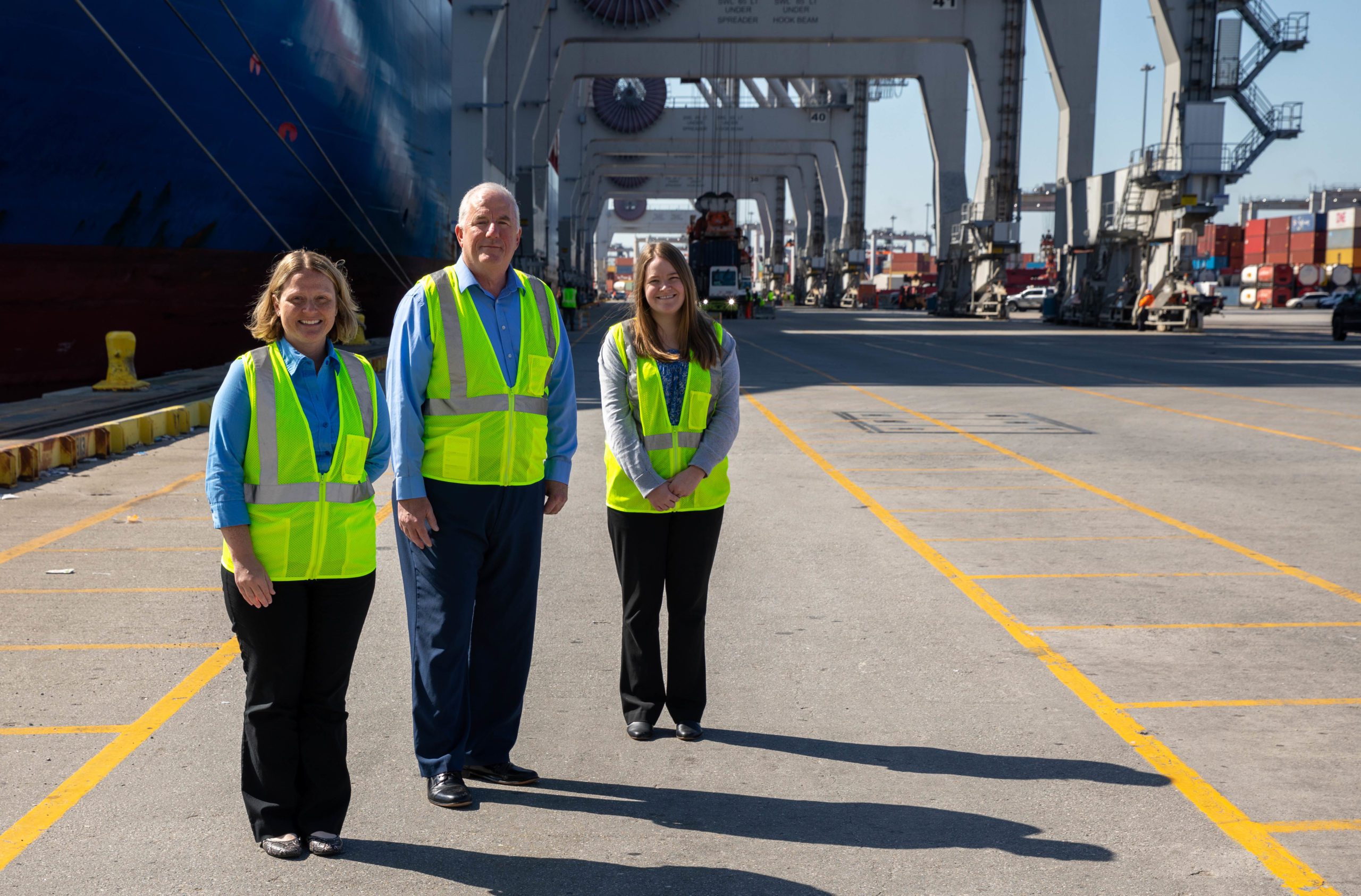Left, Manager of Marketing and Business Development Jennifer Tatom, Manager of Market Research Bill Barrs and Market Research Analyst Lainey Parson provide market research and support for many departments at Georgia Ports.
Analysts keep track of cargo volumes, industry trends
Have you ever wondered how many cranberries will fit in a 20-foot shipping container? How about how many containers of kaolin clay cross the docks at the Port of Savannah each year? Have you ever been curious to know how much pickled, peppered chicken feet are consumed overseas on an annual basis?
There is one team at Georgia Ports that keeps track of these statistics, and many more. GPA’s marketing team provides market research and support to nearly every department throughout the organization. Manager of Marketing and Business Development Jennifer Tatom said the team deals with everything concerning numbers.
“We touch every area of the port,” Tatom said. “The data and reports our team provide paint a strong picture of GPA’s unmatched services and set us apart in the maritime community.”
Databases and research tools offer detailed insight into port operations including metrics at the nation’s third busiest container gateway and second busiest auto port. These statistics include rail visibility, commodity tonnage, loaded imports and exports, and units of autos and heavy machinery. Market Analyst Lainey Parson added that although some reports may seem simple, they’re often quite complex.
“People have no idea just how much goes into gathering this data,” Parson said. For instance, Parson sifts through more than 200,000 company names to consolidate and streamline a list of the Port of Savannah’s top customers. This process takes several days to complete and includes scraping the extensive database for duplicate information.
Manager of Market Research Bill Barrs stressed that ensuring the reliability, predictability and accuracy of data and reports distributed internally and externally is also critical.
“We want to accurately depict what’s happening to the best of our ability,” Barrs said. “We have several data sources to cross-reference information.” The team uses a wide range of sources to verify information including internal GPA data, government sources such as the U.S. Census Bureau, U.S. Department of Agriculture, and U.S. Department of Commerce as well as industry leading vendors and external websites.
The team generates a wide variety of reports that track cargo and industry trends including container volumes, competitive throughput, rail volumes and global carrier services. These statistics are also used to keep GPA’s presentation materials up to date.
Some data has been used to identify potential growth segments for business, such as additional perishable cargo now being routed to Savannah. Much of the citrus currently moving through Georgia was previously processed at other East Coast ports. Barrs said he now pays more attention to produce labels when in the grocery store.
“I tend to notice things in my environment,” Barrs said. “Consumers would be surprised to learn how much cargo is handled in Savannah.” In fact, the Port of Savannah handled more than 10 percent of the total loaded U.S. container market during Calendar Year 2021.
Marketing data has proven useful in helping GPA predict the future as well, the team said. The available statistics offer insight into how current events might impact the global community.
“We see current events evolving and dig deeper to see how it’s going to affect us,” Parson said. “It’s exciting to see how relevant our reports can be.” Reports and data provided by the marketing team were helpful in predicting trends throughout the COVID-19 pandemic, during which lockdowns and increased demand led to unprecedented cargo volumes. Marketing data also provided supply chain insight during last year’s blockage of the Suez Canal and this year’s geopolitical conflict involving Russia and Ukraine.
Tatom said communities around the state also realize how vital the trade flowing through Georgia’s ports is to the economy. During the COVID-19 pandemic, Savannah served as a port of entry for pharmaceuticals and critical Personal Protective Equipment (PPE).
“It’s all fascinating because the world is so interconnected,” Tatom said. “So much of what you buy comes through Georgia.”
In case you’re still wondering, 25 million cranberries fit into a 20-foot container, GPA handled 111,000 twenty-foot equivalent container units of kaolin clay last year and 55,000 TEUs of frozen chicken paws were exported globally.
